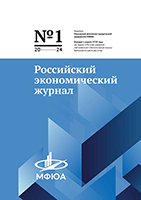Архив
Российский экономический журнал 3 / 2019
Правило «невозможной троицы» в контексте международного опыта
Цховребов М.П., Танасова А.С.
Цховребов М.П., кандидат экономических наук, младший научный сотрудник Центра денежно-кредитной политики и финансовых рынков Финансового университета при Правительстве РФ,
Танасова А.С., кандидат экономических наук, заместитель директора Центра денежно-кредитной политики и финансовых рынков Финансового университета при Правительстве РФ
Аннотация. Статья посвящена «трилемме» политики денежных властей, или «правилу невозможной троицы». Это правило совместимости целей политики, сформулированное более 50 лет назад, остается актуальным и сегодня. Его достоверность в целом подтверждается рядом эмпирических исследований, хотя известны и предложения о необходимости корректировки данной экономико-теоретической разработки. Соответствующая дискуссия затрагивает и политику Банка России (мегарегулятора), осуществляющего таргетирование инфляции в условиях свободы трансграничного движения капитала и применения плавающего курса рубля. Относительно принципиальной эффективности этой политики, проводимой при наличии повышенной чувствительности российской экономики к внешним шокам, авторы высказывают определенные сомнения.
Ключевые слова: «трилемма невозможности», «правило невозможной троицы», денежные власти, денежно-кредитная (монетарная) политика, обменный курс национальной валюты, курсовая политика, волатильность валютного курса, таргетирование инфляции, трансграничное движение капиталов, мегарегулятор, ЦБ РФ.
«The Impossible Trinity» rule in the context of international experience
Tskhovrebov M.P.,
PhD (Economics), Junior Researcher, Center for Monetary Policy and Financial Markets of the Financial University under the Government of the Russian Federation,
Tanasova A.S.,
PhD (Economics), Deputy Director of the Center for Monetary Policy and Financial Markets of the Financial University under the Government of the Russian Federation
Abstract. The article is devoted to the «Trilemma» of the policy of the monetary authorities, or the «rule of impossible trinity». This policy compatibility rule, formulated more than 50 years ago, remains relevant today. Its reliability is generally confirmed by a number of empirical studies, although there are also suggestions on the need to adjust this economic and theoretical development. The corresponding discussion also affects the policy of the Bank of Russia (mega-regulator), which carries out inflation targeting in conditions of the free movement of cross-border capital and the use of a floating ruble exchange rate. Regarding the effectiveness of this policy, carried out in the presence of increased sensitivity of the Russian economy to external shocks, the authors express certain doubts.
Keywords: «Trilemma of impossibility», «rule of impossible trinity», monetary authorities, monetary policy, exchange rate of national currency, exchange rate policy, exchange rate volatility, inflation targeting, cross-border movement of capital, mega-regulator, CBR.
DOI: 10.33983/0130-9757-2019-3-3-90-96
Библиографический список
1. Петров Ю.А. Концептуальные вопросы создания в России контрциклической системы налогового и внешнеэкономического регулирования // Российский экономический журнал. — 2017. — № 5. — С. 30–56.
2. Серегина С.Ф., Ларионова М.Л. Становление европейского банковского союза и «кипрская антикризисная модель» // Российский экономический журнал. — 2014. — № 1. — С. 40–65.
3. Aizenman J. (2013), The Impossible Trinity — from the Policy Trilemma to the Policy Quadrilemma // Global Journal of Economics. — 2013. — Vol. 02. — № 01. — P. 1–17.
4. Aizenman J., Chinn M., Ito H. Surfing the Waves of Globalization: Asia and Financial Globalization in the Context of the Trilemma // Journal of the Japanese and International Economies. — 2011. — Vol. 25. — № 3. — P. 290–320.
5. Aizenman J., Chinn M., Ito H. The Emerging Global Financial Architecture: Tracing and Evaluating the New Patterns of the Trilemma’s Configurations // Journal of International Money and Finance. — 2010. — Vol. 29. — № 4. — P. 615–641.
6. Aizenman J., Chinn M., Ito, H. The Financial Crisis, Rethinking of the Global Financial Architecture, and the Trilemma. — URL: http://www.adbi.org/working-paper/2010/04/19/3657.financial.crisis.gfa.trilemma/.
7. Aizenman J., Menzie D. Chinn, Hiro Ito The Emerging Global Financial Architecture: Tracing and Evaluating the New Patterns of the Trilemma’s Configurations // Journal of International Money and Finance. — 2010. — Vol. 29. — № 4. — P. 615–641.
8. Frenkel R. An Appraisal of Floating Exchange Rate Regimes in Latin America. — URL: https://ideas.repec.org/p/ais/wpaper/1512.html.
9. Klein Michael W., Shambaugh Jay C. (2015) Rounding the Corners of the Policy Trilemma: Sources of Monetary Policy Autonomy. — URL: https://ideas.repec.org/p/nbr/nberwo/19461.html.
10. Obstfeld M., Shambaugh Jay C. Rethinking Exchange Rate Regimes After the Crisis, IMF. — URL.: https://www.imf.org/external/np/seminars/eng/2013/macro2/pdf/jcs2.pdf.
11. Ostry, J., Ghosh A., Chamon M. Two Targets, Two Instruments: Monetary and Exchange Rate Policies in Emerging Market Economies — URL: https://www.imf.org/external/pubs/ft/sdn/2012/sdn1201.pdf.
12. Glick R., Hutchison M. Navigating the Trilemma: Capital Flows and Monetary Policy in China. — URL.: https://www.frbsf.org/economic-research/files/wp08-32bk.pdf.
13. Rey H. Dilemma not Trilemma: The Global Financial Cycle and Monetary Policy Independence. — URL: https://www.nber.org/papers/w21162.
14. Schoenmaker D. The Financial Trilemma // Economic Letters — 2011. — № 11. — P. 57–59.
15. Shambaugh Jay C. The Effect of Fixed Exchange Rates on Monetary Policy // Quarterly Journal of Economics. — 2004. — Vol. 119. — № 1. — P. 301–352.
16. Shambaugh Jay C., Alan M. Taylor (2005) The Trilemma in History: Tradeoffs among Exchange Rates, Monetary Policies and Capital Mobility // Review of Economics and Statistics. — 2005. — № 87 (3). — P. 423–438.

